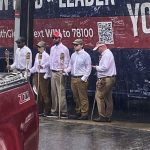
The U.S. Navy Memorial will unveil a sculpture on Veterans Day in honor of war dogs, the first of its kind in the nation’s capital.
The statue will join exhibits permanently at the memorial’s visitors center in recognition of all “men and women of the sea services” and “the canines who fought and died for our country,” sculptor Susan Bahary told The Washington Times.
“Let’s face it; they are part of the military as well,” Ms. Bahary said.
The bronze statue depicts Navy sailor John Douangdara and his Belgian Malinois, Bart. Both died in Afghanistan when Taliban fighters shot down their helicopter in August 2011. The attack killed all 29 service members aboard, including 17 Navy SEALS.
Modeled on a photograph taken in Afghanistan, the larger-than-life statue depicts the sailor seated with his right hand holding a gun and his left hand touching the dog.
Douangdara, the lead dog handler for Seal Team 6, had prepared Bart as a “force multiplier” to assist with a rescue operation on the day they died.
“The Navy Memorial is proud that we will host the statue honoring Petty Officer Douangdara and Military Working Dog Bart, both of whom gave their lives for the United States,” said retired Rear Adm. Frank Thorp, president and CEO of the memorial.
Ms. Bahary designed the nation’s first official war dog memorial, a life-sized bronze statue of a Doberman titled “Always Faithful.” That statue was unveiled at the Pentagon and installed in the National War Dog Cemetery at Naval Base Guam in 1994.
The U.S. War Dogs Association commissioned Ms. Bahary last year to create the statue of Douangdara and Bart.
Chris Willingham, the president of the nonprofit association, said the petty officer and his dog died “three months after Osama bin Laden was killed, during a dangerous time in Afghanistan.”
“There were several candidates worthy of recognition and honor, but John and Bart just kept coming up. You have to be at the top of your game as a well-developed dog team to work with SEALs,” he said.
Mr. Willingham, who worked with a war dog during his 20 years in the Marine Corps, said the statue complements the association’s work of covering prescription medications for 1,100 retired war dogs.
Ms. Bahary, who resides in the San Francisco Bay Area, has sculpted animals for 30 years. She said it took about a year to finish the Navy Memorial statue.
The Belgian Malinois, similar to the German shepherd, is the most common breed in the U.S. military today because of its ability to “go into small places and carry complex equipment with cameras and radio devices,” she said.
“They are just very eager to work, a little lighter than a German shepherd, easier to carry and a little faster. They can do things with their keen sense of smell, hearing, size and agility to get ahold of the enemy and save lives in the process,” she said.
War dogs rarely get publicity when they die on the battlefield or “retire” from the military and join adoptive families.
“We’re trying to get official medals for the dogs, but that has not happened yet,” Ms. Bahary said.








